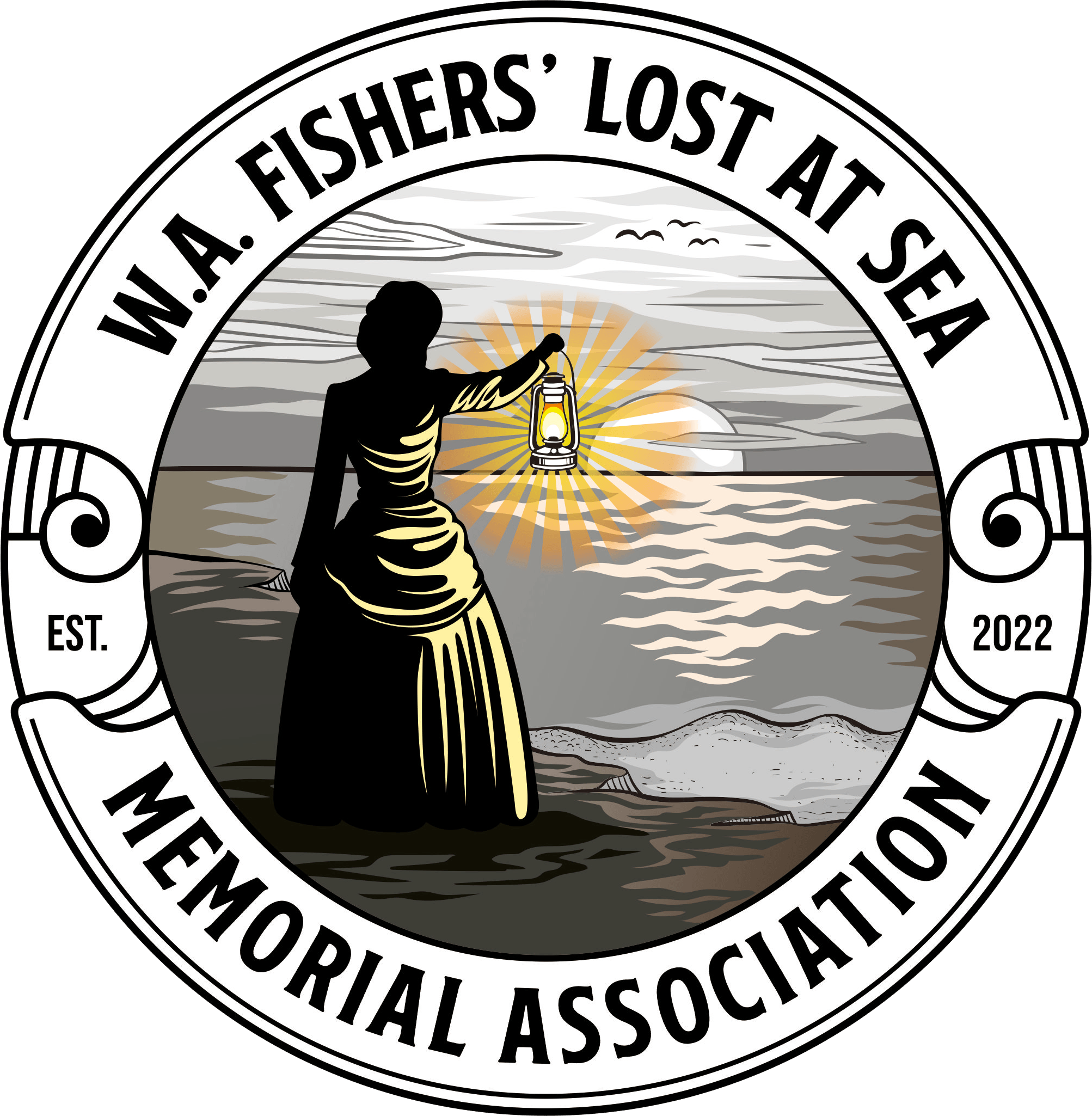Villaret
Vessel Name: Villaret
Keith Raymond “Digby” Milner
Richard Owen Williams
Two newsmen killed in light aircraft crash; Bodies recovered
28 November 1960
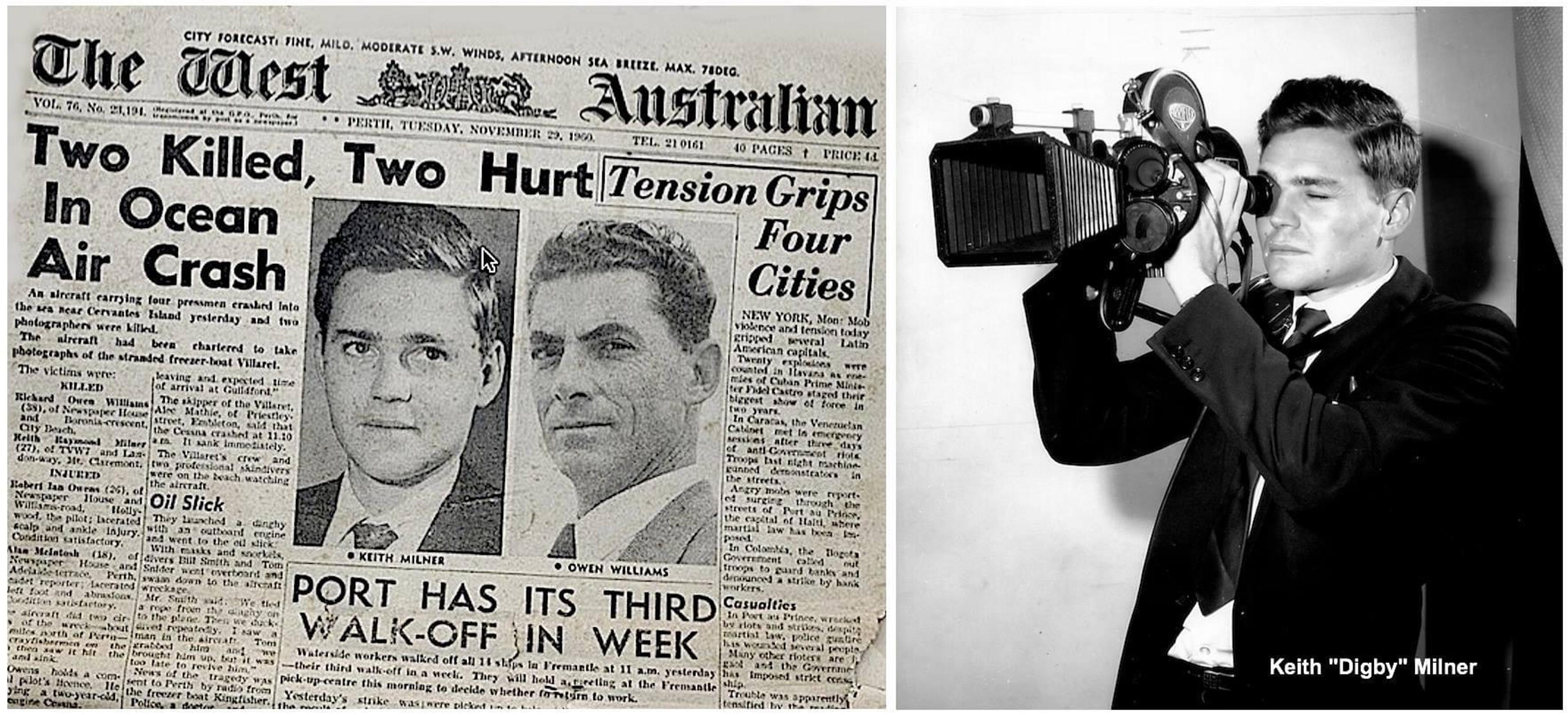
Front Page The West Australian, Tuesday November 29, 1960
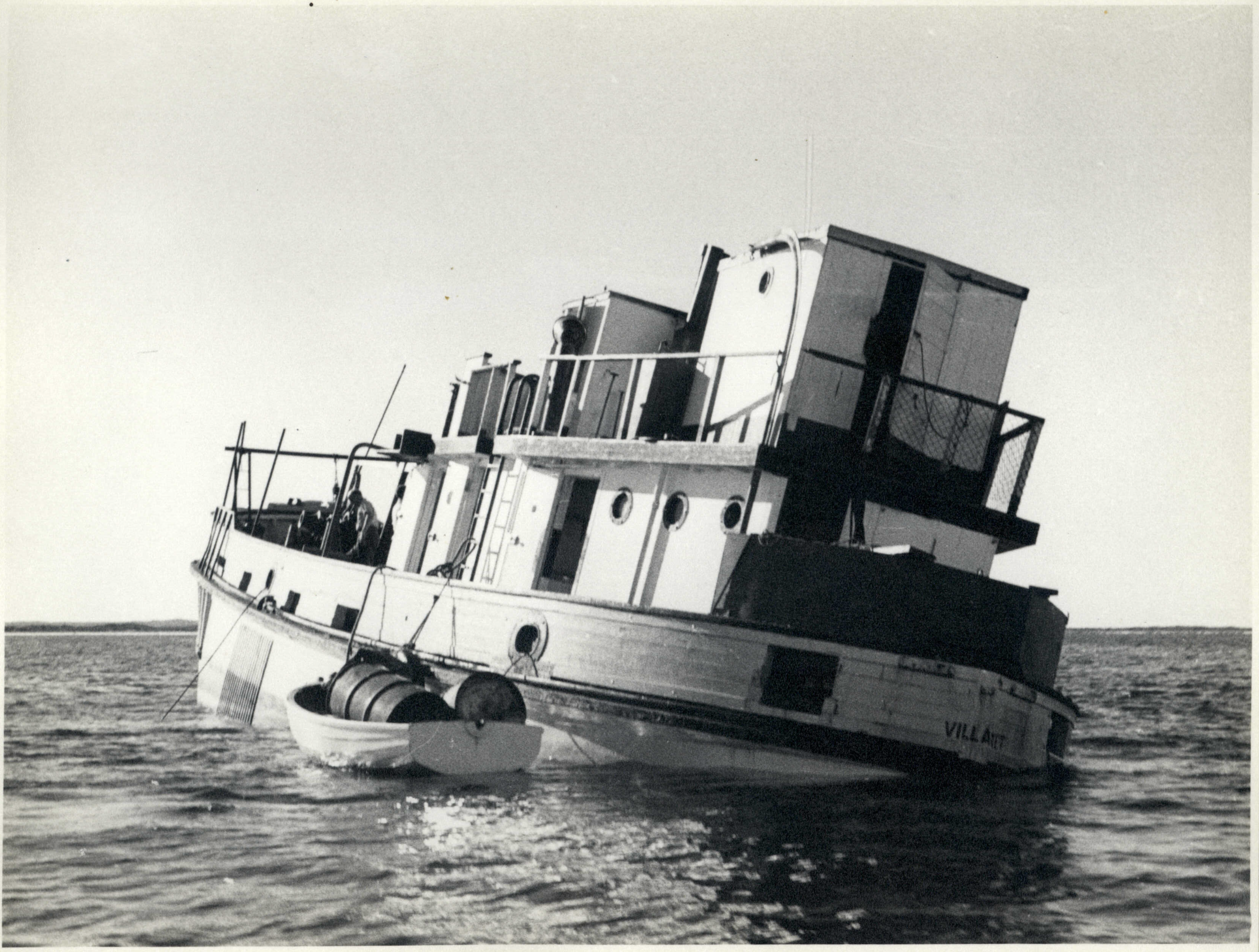
Villaret in Cervantes Bay

The Wreck of the Cessna
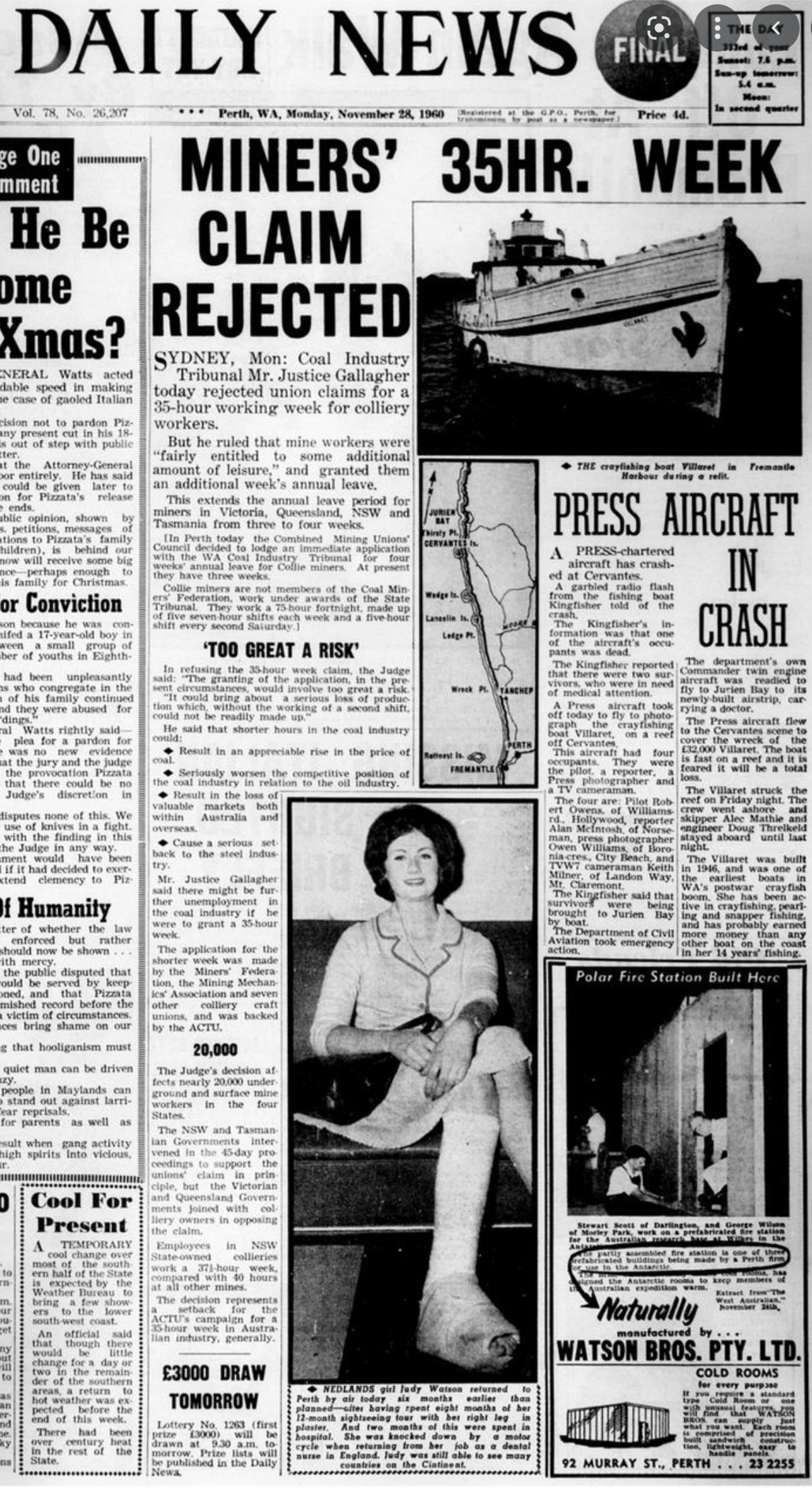
The Daily News, Monday November 28, 1960
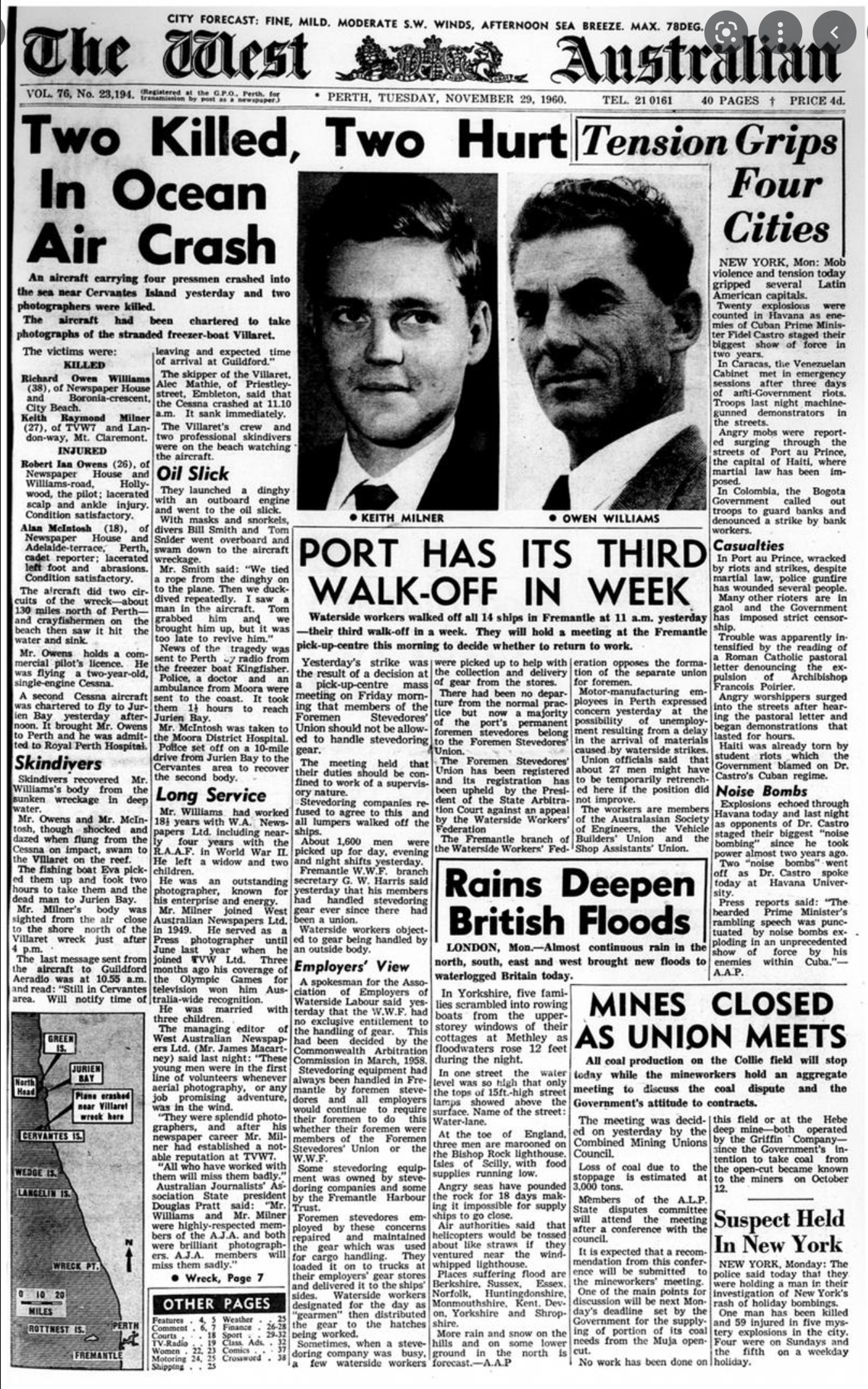
The West Australian, Tuesday November 29, 1960
The Villaret was an 82 foot crayfishing freezer boat, which struck a reef two miles North of Cervantes on the 25 November 1960. It was holed four times but held fast on the reef. The crew safely went ashore, including the Skipper, Alec Mathie, together with Engineer Doug Threlkeld.
The Villaret was built in 1946 and was one of the earliest boats in WA’s post-war crayfish boom. She had been active in crayfishing, pearling and snapper fishing, and had probably earnt more money than any other boat on the coast. She was valued at £32,000 and a claim for £26,000 was paid out by the Insurance Company.
The wreck was salvaged and rebuilt as the Western Star.
The mishap did not end there. A press aircraft took off on the 28 November to photograph the wreck. The two year old, single engine Cessna did two circuits of the wreck, including a last run at a height of 150 feet, before crashing into the water at 11:10am and cartwheeling.
Weather at the time of the plane crash was fine and wind about 15 knots. The aircraft sank immediately in nine fathoms of water, 1.25 miles off Cervantes shore, approximately ¾ miles South East of the Villaret. The plane was later raised from the sea and examined by the Civil Aviation Authorities.
The aircraft had four occupants:
Pilot, Robert Ian Owens (26),
Cadet Reporter, Alan Edwardes McIntosh (18),
Press Photographer, (Richard) Owen “Willie” Williams (38), and
TVW7 cameraman, Keith Raymond “Digby” Milner (27).
It was Owen Williams’ day off, but Keith had suggested he come along for the ride to get more skills for his role. Owens and McIntosh survived the impact and swam to the Villaret on the reef. The Villaret’s crew and two professional salvage contractors (Thomas Isiah Snider and his assistant William Errol Smith) were on the beach watching the aircraft. They launched a dinghy with an outboard engine and immediately attended to the area where an oil slick had gathered. They tied a rope from the dinghy to the plane and repeatedly duck-dived.
Smith saw the body of Williams and Snider brought him up, but it was too late to revive him. They made their way to the Villaret, where they found Owens and McIntosh in a dazed condition. Snider attempted to make radio contact for assistance, but the radio onboard the Villaret was damaged. Snider then took the dinghy and William’s body to the shore to seek medical aid for the survivors.
Smith rigged a signal for assistance on the mast, and the fishing boat, Eva, picked them up. It took two hours to take them, and the body of Owen Williams, to Jurien Bay. Milner’s body was sighted North of the Villaret wreck later in the afternoon and was recovered by Police early the next day two to three miles North from the crash-site.
News of the tragedy was sent to Perth by radio from the Freezer boat, Kingfisher. Survivors were initially bought to Jurien Bay for medical attention.
The Department of Civil Aviation took emergency action and flew its own Commander twin-engine aircraft, carrying a doctor. Owens sustained a laceration to the scalp and ankle injury. McIntosh had a laceration to his left foot and abrasions.
According to McIntosh, Milner and Williams were standing on the wings, urging the pilot to go lower so they could get better pictures. The pilot, Robert Owens was interviewed by Police whilst he was being treated for his injuries in Royal Perth Hospital.
He stated: “Piloting Cessna aircraft over Cervantes Islands to photograph wrecked cray boat – Contacted DLA wireless and informed them over Islands – Made downing run over boat at approx. 400’ alt. then three or four runs anti clockwise- getting closer each time – 7 V started shooting & seemed fairly happy – Milner took shots – asked to make gradual decent by Milner so he could take head-on – turned head on into wind – Sth West got pictures – pulled away at 50’ alt. – straight ahead into wind – Milner handed over to Newspaper photographer – He waited to take snaps from the side. I did a fairly sharp turn – call it steep turn – Rate 3 to 4 turn. To do photographic work it is necessary to throttle back, - Note – During run around boat I had 10 degrees of flap on wings – safety measure – Makes it safer to fly slow. Commenced to turn right & stalled – not viciously – estim. Height – 120’ to 150’ maybe stalled – I mean flopped – I realised I could not put on power as nose was down. Had 1600 rev’s – ½ power, After that I let the throttle go & took control column with both hands – It didn’t high speed stall – It didn’t recover – struck sea at about 10 degrees heading in – tail breeze – nth east. When hit water nose went in and then up and then sunk back. I was shot out. Two others got out – I saw them a short distance away – I saw McIntosh and Milne in the water.” At this time Owens was feeling faint and required further medical attention.
According to James Macartney, the managing editor of the West Australian Newspapers Ltd at the time, Milner and Williams were always the first line of volunteers whenever aerial photography, or any job promising adventure, was in the wind.
Milner had started his career as a press photographer, before going on to TVW Channel 7 where his coverage of the 1960 Rome Olympics won him nationwide recognition. TVW was the only television station in Australia to send a team to the summer Olympics in Rome, and Channel 7 had been operational for little more than one year when the tragedy occurred.
The news of the death was conveyed to the Milner family home by Channel 7’s news director, Darcy Farrell, and senior executive, Syd Donovan.
Milner left behind a wife, Berwyn, and sons Greg (5) and Peter, and daughter Kerry. Greg followed his Father’s footsteps in media, and worked as a Cadet Journalist, alongside McIntosh. Peter also worked with Channel 7 in accounts.
Williams was a World War II veteran with the R.A.A.F and regarded as an outstanding photographer, with nearly two decades of experience. He left behind a wife Marjorie Jean, son Kent (9) and daughter Sheryl. Kent retained a seat cushion as a remnant of the plane and recalls spending time with his father the day before the crash. Williams was a shift worker and was often at home during the day. The day prior he recalls him lying on the couch, and typical of an ex-vet, was drinking a king brown beer.
McIntosh had bad memories of the crash. He had nightmares and a permanent limp and didn’t like flying after the experience. He died in 1987.
In 2020, the Milner and Williams families gathered in Cervantes for an emotional ceremony marking the tragedy that occurred 60 years prior. A plaque was dedicated in a mission for closure. They gather annually to commemorate their loss and find some closure for the events that transpired.
